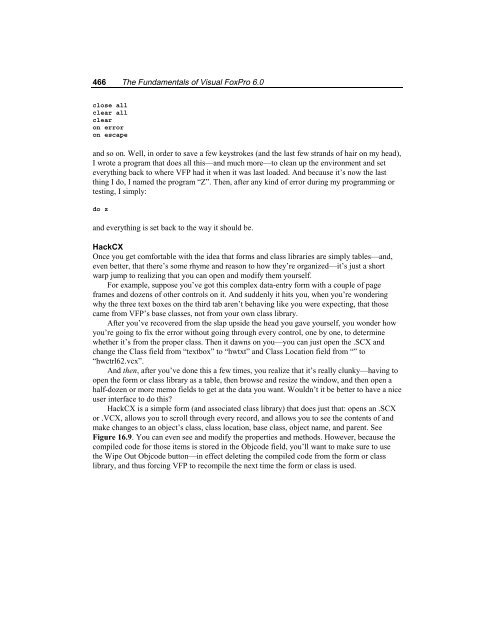Chapter 16 Customizing Your Development ... - dFPUG-Portal
Chapter 16 Customizing Your Development ... - dFPUG-Portal
Chapter 16 Customizing Your Development ... - dFPUG-Portal
Create successful ePaper yourself
Turn your PDF publications into a flip-book with our unique Google optimized e-Paper software.
466 The Fundamentals of Visual FoxPro 6.0<br />
close all<br />
clear all<br />
clear<br />
on error<br />
on escape<br />
and so on. Well, in order to save a few keystrokes (and the last few strands of hair on my head),<br />
I wrote a program that does all this—and much more—to clean up the environment and set<br />
everything back to where VFP had it when it was last loaded. And because it’s now the last<br />
thing I do, I named the program “Z”. Then, after any kind of error during my programming or<br />
testing, I simply:<br />
do z<br />
and everything is set back to the way it should be.<br />
HackCX<br />
Once you get comfortable with the idea that forms and class libraries are simply tables—and,<br />
even better, that there’s some rhyme and reason to how they’re organized—it’s just a short<br />
warp jump to realizing that you can open and modify them yourself.<br />
For example, suppose you’ve got this complex data-entry form with a couple of page<br />
frames and dozens of other controls on it. And suddenly it hits you, when you’re wondering<br />
why the three text boxes on the third tab aren’t behaving like you were expecting, that those<br />
came from VFP’s base classes, not from your own class library.<br />
After you’ve recovered from the slap upside the head you gave yourself, you wonder how<br />
you’re going to fix the error without going through every control, one by one, to determine<br />
whether it’s from the proper class. Then it dawns on you—you can just open the .SCX and<br />
change the Class field from “textbox” to “hwtxt” and Class Location field from “” to<br />
“hwctrl62.vcx”.<br />
And then, after you’ve done this a few times, you realize that it’s really clunky—having to<br />
open the form or class library as a table, then browse and resize the window, and then open a<br />
half-dozen or more memo fields to get at the data you want. Wouldn’t it be better to have a nice<br />
user interface to do this?<br />
HackCX is a simple form (and associated class library) that does just that: opens an .SCX<br />
or .VCX, allows you to scroll through every record, and allows you to see the contents of and<br />
make changes to an object’s class, class location, base class, object name, and parent. See<br />
Figure <strong>16</strong>.9. You can even see and modify the properties and methods. However, because the<br />
compiled code for those items is stored in the Objcode field, you’ll want to make sure to use<br />
the Wipe Out Objcode button—in effect deleting the compiled code from the form or class<br />
library, and thus forcing VFP to recompile the next time the form or class is used.

















